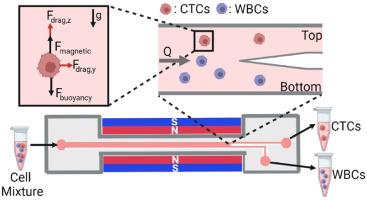Biosensors and Bioelectronics: X Pub Date : 2023-08-26 , DOI: 10.1016/j.biosx.2023.100392 Seren Kecili , Esra Yilmaz , Ozge Solmaz Ozcelik , Muge Anil-Inevi , Zehra Elif Gunyuz , Ozden Yalcin-Ozuysal , Engin Ozcivici , H. Cumhur Tekin

|
Circulating tumor cells (CTCs) are crucial indicators of cancer metastasis. However, their rarity in the bloodstream and the heterogeneity of their surface biomarkers present challenges for their isolation. Here, we developed a hybrid microfluidic platform (microfluidic-based density-associated cell sorting (µDACS) platform) that utilizes density as a biophysical marker to sort cancer cells from the population of white blood cells (WBCs). The platform utilizes the magnetic levitation technique on a microfluidic chip to sort cells based on their specific density ranges, operating under a continuous flow condition. By harnessing magnetic, gravitational, and drag forces, the platform efficiently separates cells. This approach involves a microfluidic chip equipped with a microseparator, which directs cells into top and bottom outlets depending on their levitation heights, which are inversely proportional to their densities. Hence, low-density cancer cells are collected from the top outlet, while high-density WBCs are collected from the bottom outlet. We optimized the sorting efficiency by varying the flow rates, and concentrations of the sorting medium's paramagnetic properties using standard densities of polymeric microspheres. To demonstrate the platform's applicability, we performed hybrid microfluidic sorting on MDA-MB-231 human breast cancer cells and U-937 human monocytes. The results showed efficient sorting of rare cancer cells (≥100 cells/mL) from serum samples, achieving a sorting efficiency of ∼70% at a fast-processing speed of 1 mL h−1. This label-free approach holds promise for rapid and cost-effective CTC sorting, facilitating in-vitro diagnosis and prognosis of cancer.
中文翻译:

μDACS平台:一种混合微流控平台,采用磁悬浮技术并集成磁力、重力和阻力,用于基于密度的稀有癌细胞分选
循环肿瘤细胞(CTC)是癌症转移的重要指标。然而,它们在血流中的稀有性和表面生物标志物的异质性给它们的分离带来了挑战。在这里,我们开发了一种混合微流体平台(基于微流体的密度相关细胞分选(μDACS)平台),利用密度作为生物物理标记从白细胞(WBC)群中分选癌细胞。该平台利用微流控芯片上的磁悬浮技术,根据细胞的特定密度范围对细胞进行分类,并在连续流动条件下运行。通过利用磁力、重力和阻力,该平台可以有效地分离细胞。这种方法涉及配备有微分离器的微流控芯片,它根据细胞的悬浮高度将细胞引导到顶部和底部出口,而悬浮高度与其密度成反比。因此,低密度癌细胞从顶部出口收集,而高密度白细胞从底部出口收集。我们通过使用聚合物微球的标准密度改变分选介质的顺磁特性的流速和浓度来优化分选效率。为了证明该平台的适用性,我们对 MDA-MB-231 人乳腺癌细胞和 U-937 人单核细胞进行了混合微流体分选。结果显示,可以从血清样本中有效分选罕见癌细胞(≥100 个细胞/mL),以 1 mL·h 的快速处理速度实现约 70% 的分选效率 因此,低密度癌细胞从顶部出口收集,而高密度白细胞从底部出口收集。我们通过使用聚合物微球的标准密度改变分选介质的顺磁特性的流速和浓度来优化分选效率。为了证明该平台的适用性,我们对 MDA-MB-231 人乳腺癌细胞和 U-937 人单核细胞进行了混合微流体分选。结果显示,可以从血清样本中有效分选罕见癌细胞(≥100 个细胞/mL),以 1 mL·h 的快速处理速度实现约 70% 的分选效率 因此,低密度癌细胞从顶部出口收集,而高密度白细胞从底部出口收集。我们通过使用聚合物微球的标准密度改变分选介质的顺磁特性的流速和浓度来优化分选效率。为了证明该平台的适用性,我们对 MDA-MB-231 人乳腺癌细胞和 U-937 人单核细胞进行了混合微流体分选。结果显示,可以从血清样本中有效分选罕见癌细胞(≥100 个细胞/mL),以 1 mL·h 的快速处理速度实现约 70% 的分选效率 以及使用聚合物微球的标准密度的分选介质的顺磁特性的浓度。为了证明该平台的适用性,我们对 MDA-MB-231 人乳腺癌细胞和 U-937 人单核细胞进行了混合微流体分选。结果显示,可以从血清样本中有效分选罕见癌细胞(≥100 个细胞/mL),以 1 mL·h 的快速处理速度实现约 70% 的分选效率 以及使用聚合物微球的标准密度的分选介质的顺磁特性的浓度。为了证明该平台的适用性,我们对 MDA-MB-231 人乳腺癌细胞和 U-937 人单核细胞进行了混合微流体分选。结果显示,可以从血清样本中有效分选罕见癌细胞(≥100 个细胞/mL),以 1 mL·h 的快速处理速度实现约 70% 的分选效率−1。这种无标记方法有望实现快速且经济高效的 CTC 分选,促进癌症的体外诊断和预后。



























 京公网安备 11010802027423号
京公网安备 11010802027423号